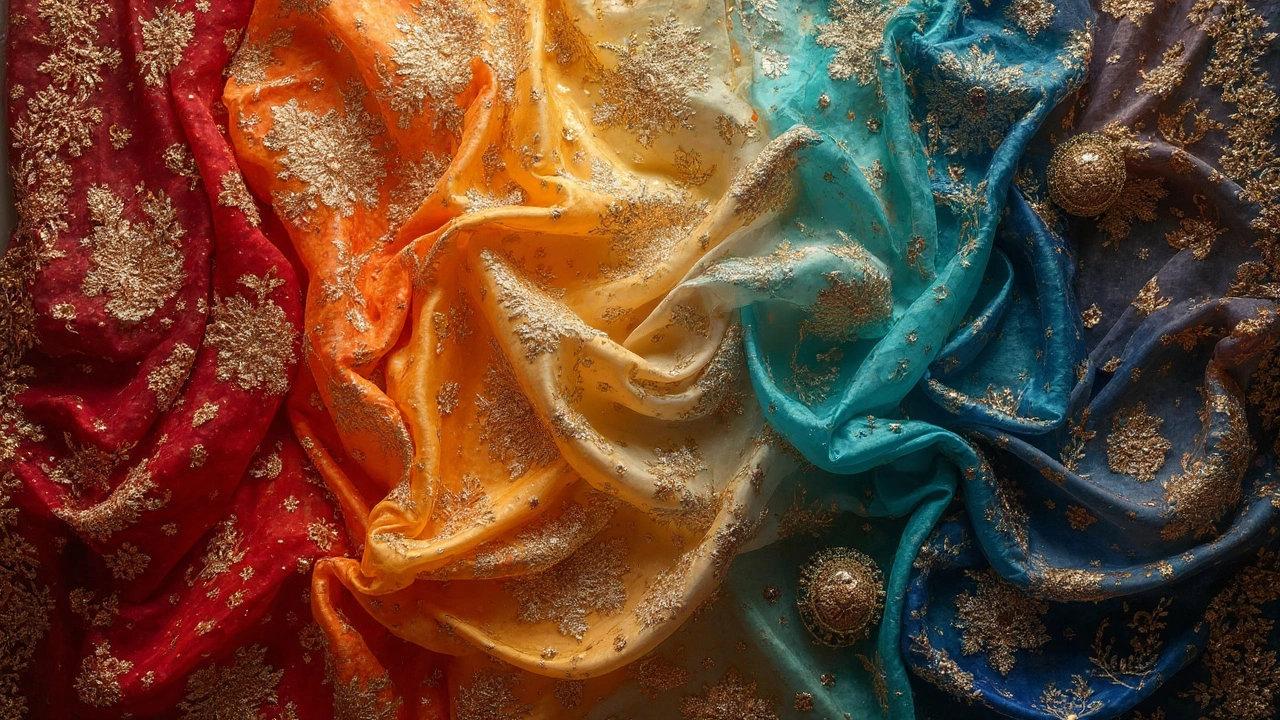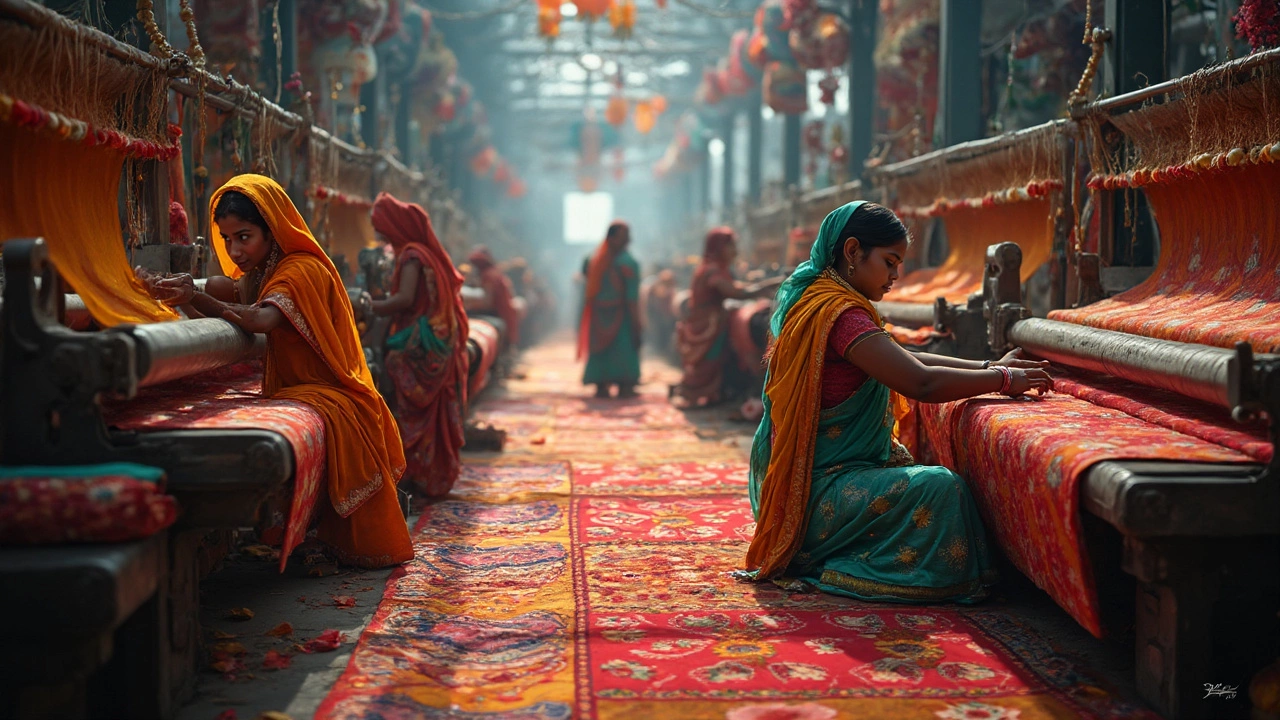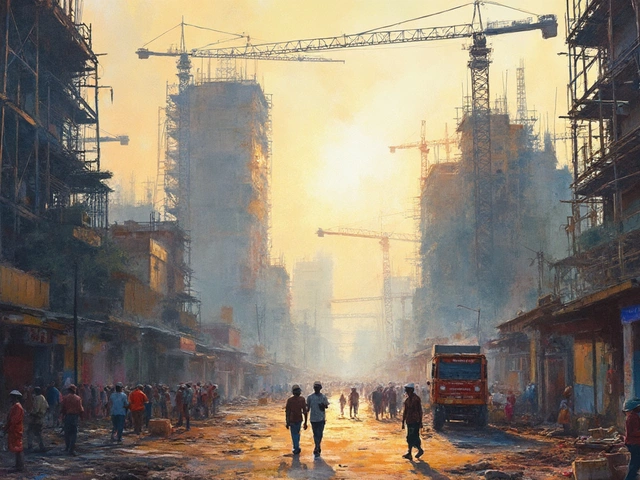Ever thought about diving into the textile world? Well, if you're looking for a major player in this area, India should be popping up on your radar. Over the years, India has carved out a pretty sweet spot in the global textile industry. With centuries of experience, this country's got both the history and the modern tech needed to really shine.
For starters, the workforce here is one big factor. There's a whole bunch of skilled workers who know the ins and outs of fabric production—whether it's weaving incredible patterns or creating high-quality synthetic materials. On top of that, India offers competitive pricing, which doesn’t hurt when you're trying to turn a profit in a cutthroat market.
If sustainability's your thing, you'll find India’s commitment to eco-friendly practices a refreshing change from some typical industrial stories. They’re integrating green solutions like there's no tomorrow, proving that business can thrive without trashing the planet.
- The Rich Heritage of Indian Textiles
- Competitive Advantages of India
- Technological Advancements in the Indian Textile Sector
- India's Focus on Sustainability
- Key Challenges and How India Overcomes Them
- Tips for Starting a Textile Business in India
The Rich Heritage of Indian Textiles
India's textile heritage isn’t just about today's bustling industry; it's a real, lived historical journey. Going back over 5,000 years, the importance of textiles in India can be seen from the time of the Indus Valley Civilization where dyed cotton fabrics were common. Can you believe that? People were already into stylish fabrics back then!
Throughout history, India has been a global supplier of everything from silk to cotton, attracting traders from all over the world. Ever heard of the famous Muslin from Dhaka or the luxurious Pashmina wool from Kashmir? Both come from India and have a rich heritage that's kept the country on the textile map.
In fact, Indian textiles were such a big deal that they played a major part during the colonial era. The British cotton industry felt threatened by the quality and demand of Indian fabric, leading to major changes in policies. Products like block-printed cottons were all the rage in Europe, showing off India's exceptional craftsmanship.
What makes India's textile industry stand out even today is not just its history, but its savvy blend of traditional techniques and modern practices. Artisans still use age-old methods like handloom weaving and natural dyeing while pairing them with new technologies. This means you get fabrics that are both a nod to tradition and a testament to innovation.
The country isn't just sitting on its laurels, though. It's embracing trends in sustainability and pushing the boundaries with innovative fabrics. So, whether it's beautiful silk sarees or eco-friendly textiles, India keeps its textile trade thriving.
All in all, India’s rich textile legacy is a blend of cultural pride and global influence—a perfect mix for a booming business.
Competitive Advantages of India
When it comes to the textile business, India is like a magnet for investors around the globe, and for good reason. First off, imagine having access to one of the world's largest resources of cotton and jute. This not only makes raw materials more affordable but also ensures you're getting top-notch quality. Plus, India textile manufacturers have found the sweet spot between traditional craftsmanship and modern efficiency.
Let's not forget the labor force. With over 45 million people working directly in the textile industry, you're looking at a skilled yet cost-effective labor pool. This massive workforce keeps production costs low while maintaining quality standards—something every business owner wants. And if you’re worried about keeping up with fashion trends, India’s got you covered. The agility and adaptability of its labor mean you can quickly shift production to match the latest fashion needs.
Why else is India a go-to destination? Well, the government here doesn’t just stand on the sidelines. Various incentives and schemes are in place to support textile businesses. From favorable tax policies to export promotions, India’s backing makes it easier for companies to spread their wings in the global textile market. Take the Technology Upgradation Fund Scheme (TUFS), for instance; it's aimed at enhancing productivity and opening doors to state-of-the-art tech for manufacturers.
And for those who value tech, Indian manufacturers aren't lagging. They've got some of the latest machinery and technology in their factories. This means faster production times and the ability to produce intricate designs a piece of cake.
| Resource | India's Ranking Globally |
|---|---|
| Cotton Production | 2nd |
| Jute Production | 1st |
| Silk Production | 2nd |
In simpler terms, if you’re ready to jump into the textile industry pool, India’s waters are warm and welcoming. It's got the goods, the people, the support, and the know-how all bundled into one vibrant package, making it a no-brainer choice.
Technological Advancements in the Indian Textile Sector
Let's face it, the textile game isn't just about spinning threads anymore; it's about weaving innovation into every strand. And guess what? India is totally nailing it with cutting-edge tech in its textile industry. This isn’t the same old fabric story; we’re talking automation, AI, and even some mind-blowing digital tech here.
One of the biggest leaps? The integration of textile business management software. Many Indian manufacturers are using AI-driven platforms to manage everything from supply chains to quality control. Imagine predicting market trends or fabric demands before they even happen. That's the power we've got right now.
There's also a lot happening on the production floor. Robotics are stepping in to handle repetitive tasks, making weaving and fabric cutting way more efficient. This doesn't just boost production; it keeps costs low and makes that an appealing aspect for anyone in the global textile market.
According to Raghav Sharma, CEO of a leading textile firm, "The use of technology in textiles isn’t just about speed and volume. It’s about precision, sustainability, and having a competitive edge in the global market."
And let’s talk sustainability—one of the buzzwords in modern business. From using eco-friendly dyes to recycling water in production processes, Indian companies are spearheading the effort to keep the planet happy while still producing those snazzy tees and plush fabrics we love.
Oh, and digital printing is another game-changer. Gone are the days of limited fabric design. Now, designers can go nuts with digital prints, bringing vivid patterns to life without the massive cost or time delays traditional printing methods typically rack up.
No doubt about it, if you're considering jumping into the India textile manufacturers scene, understanding these tech advancements is kinda crucial. It’s where efficiency meets creativity, all while keeping an eye on our ecological footprint. That's progress, right?
Here's a quick peek at some key tech advancements in numbers:
| Advancement | Impact |
|---|---|
| AI & Automation | Reduces production costs by 20% |
| Digital Printing | Speeds up design-to-production time by 35% |
| Eco-friendly Manufacturing | Cuts down water usage by 50% |

India's Focus on Sustainability
When chatting about the textile industry in terms of sustainability, India is making some serious waves. The country's textile businesses have started seeing the bigger picture—selling products isn't just about quick bucks anymore. It's about keeping our planet in good shape too. That's why you'll find loads of companies here going all-in on green practices.
For starters, many textile manufacturers in India are hopping on the organic bandwagon. They're using organic cotton, which ditches the harmful pesticides and fertilizers. That means healthier ecosystems and happier consumers who are keen on eco-friendly products. And let's not forget the push towards recycling. There's a growing trend in taking fabric waste and feeding it back into the production cycle instead of just tossing it.
Another biggie is water conservation. Textile production can be seriously water-intensive, but many Indian manufacturers are figuring out smart ways to cut down on usage. Technologies like waterless dyeing are slowly becoming a part of the norm. Plus, these businesses often treat and recycle water, making a significant dent in water consumption.
Here's a cool fact: According to a report, the Indian textile industry aims to achieve 20% of its energy from renewable sources by 2025. This includes tapping into solar and wind energy—a move that doesn’t just cut carbon footprints but also saves on energy costs in the long run.
The drive towards sustainability isn't just about meeting market demands or saving costs—it’s a long-term commitment. However, it's this dedication that keeps India at the forefront of the global textile market. Not only does it boost the image of Indian textiles, but it also sets the pace for others in the industry to follow.
Key Challenges and How India Overcomes Them
India's textile industry might have a lot going for it, but it's not all sunshine and rainbows. There are some pretty significant challenges that manufacturers face, but the good news is that they’re figuring out ways to tackle them.
Let’s talk about infrastructure. Sure, India has been on a development spree, but there are still areas where roads and transportation can be spotty. This can affect the speedy delivery of raw materials and finished goods. However, the government has been investing heavily in infrastructure projects, aiming to improve connectivity across the country. These efforts are gradually making logistics smoother for textile business operators.
Another biggie? Power supply. Consistent electricity is crucial, and any hiccups can halt production. India’s solution is focusing on alternative sources. Solar power has become a sustainable game-changer, with many factories now adopting solar panels to ensure they keep running even during outages.
Then there's competition from other countries. Places like Bangladesh and Vietnam are hustling hard in the global textile market, often with lower labor costs. India's edge here is its diverse range of high-quality fabrics and commitment to sustainability, which sets it apart. Plus, economic policies like reducing tariffs on raw materials have helped make Indian products more competitive.
Sometimes the reputation of a place rests on its perception. India, at times, struggles with external perceptions about quality. However, companies and the government are working together to promote the ‘Make in India’ campaign and ensure products meet international standards. This effort has been bearing fruit, with many international brands setting up shop here.
"India’s adaptability and innovation have been key in maintaining its strong position in the textile industry despite the hurdles," says Aniket Sharma, a leading expert in textile economics.
In navigating these challenges, India's textile industry shows resilience, adapting to changes and finding innovative solutions to stay ahead. So, while there are bumps along the road, India’s commitment to addressing these issues is making it a force to reckon with.
Tips for Starting a Textile Business in India
Starting a textile business in India? Great choice! The country offers a robust environment for entrepreneurs ready to tap into its vibrant industry. Here’s how to get started without hitting too many bumps in the road.
Do Your Homework: Before jumping in, research is your best friend. Understand the market demand, both locally and globally, and identify the fabric or apparel category you want to target. Knowing your niche can save heaps of time and money.
Choose the Right Location: India has several textile hubs. Consider places like Surat for synthetic fabrics or Tiruppur for knitwear. The location can impact both your cost and speed of production, so choose wisely.
Get the Paperwork Right: Navigating the paperwork jungle is crucial. Register your business to get all necessary licenses and permits. India’s textile sector has specific regulations, so ensure compliance to avoid any legal hiccups.
Network Like Crazy: In India, strong business relationships can open doors. Attend textile fairs, join industry groups, and keep those contacts handy. It's amazing how much you can learn and achieve just by staying connected.
Invest in Technology: The Indian textile market is moving towards modern tech solutions. Investing in new machinery or management software can boost efficiency and quality, giving you a competitive edge.
Plan Your Finances: Setting up a textile business can require significant capital. Make sure to plan your finances, considering both initial costs and ongoing expenses. Exploring financing options with local banks or investors might be a smart move.
India’s textile industry is thriving, and getting in on the action can be rewarding if you're prepared. With the right strategies and a bit of hustle, you'll be well on your way to making your mark.






